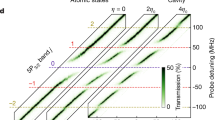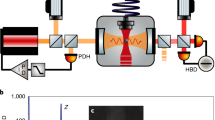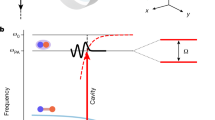Abstract
Observing quantum phenomena in strongly correlated many-particle systems is difficult because of the short length- and timescales involved. Exerting control over the state of individual elements within such a system is even more so, and represents a hurdle in the realization of quantum computing devices. Substantial progress has been achieved with arrays of Josephson junctions and cold atoms in optical lattices, where detailed control over collective properties is feasible, but addressing individual sites remains a challenge. Here we show that a system of polaritons held in an array of resonant optical cavities—which could be realized using photonic crystals or toroidal microresonators—can form a strongly interacting many-body system showing quantum phase transitions, where individual particles can be controlled and measured. The system also offers the possibility to generate attractive on-site potentials yielding highly entangled states and a phase with particles much more delocalized than in superfluids.
This is a preview of subscription content, access via your institution
Access options
Subscribe to this journal
Receive 12 print issues and online access
$209.00 per year
only $17.42 per issue
Buy this article
- Purchase on Springer Link
- Instant access to full article PDF
Prices may be subject to local taxes which are calculated during checkout





Similar content being viewed by others
References
van der Zant, H. S. J., Fritschy, F. C., Elion, W. J., Geerligs, L. J. & Mooij, J. E. Field-induced superconductor-to-insulator transitions in Josephson-junction arrays. Phys. Rev. Lett. 69, 2971–2974 (1992).
van Oudenaarden, A. & Mooij, J. E. One-dimensional Mott insulator formed by quantum vortices in Josephson junction arrays. Phys. Rev. Lett. 76, 4947–4950 (1996).
Fisher, M. P. A., Grinstein, G. & Grivin, S. M. Presence of quantum diffusion in two dimensions: Universal resistance at the superconductor-insulator transition. Phys. Rev. Lett. 64, 587–590 (1990).
Fisher, M. P. A., Weichman, P. B., Grinstein, G. & Fisher, D. S. Boson localization and the superfluid-insulator transition. Phys. Rev. B 40, 546–570 (1989).
Bruder, C., Fazio, R. & Schön, G. The Bose–Hubbard model: From Josephson junction arrays to optical lattices. Ann. Phys. 14, 566–577 (2005).
Jaksch, D., Bruder, C., Cirac, J. I., Gardiner, C. W. & Zoller, P. Cold bosonic atoms in optical lattices. Phys. Rev. Lett. 81, 3108–3111 (1997).
Greiner, M., Mandel, O., Esslinger, T., Hänsch, T. W. & Bloch, I. Quantum phase transition from a superfluid to a Mott insulator in a gas of ultracold atoms. Nature 415, 39–44 (2002).
Paredes, B. et al. TonksGirardeau gas of ultracold atoms in an optical lattice. Nature 429, 277–281 (2004).
Santos, L. et al. Atomic quantum gases in Kagomé lattices. Phys. Rev. Lett. 93, 030601 (2004).
Jaksch, D., Briegel, H. J., Cirac, J. I., Gardiner, C. W. & Zoller, P. Entanglement of atoms via cold controlled collisions. Phys. Rev. Lett. 82, 1975–1978 (1999).
Mandel, O. et al. Controlled collisions for multi-particle entanglement of optically trapped atoms. Nature 425, 937–940 (2003).
Jaksch, D. & Zoller, P. The cold atom Hubbard toolbox. Ann. Phys. 315, 52–79 (2005).
Micheli, A., Brennen, G. K. & Zoller, P. A toolbox for lattice spin models with polar molecules. Nature Phys. 2, 341–347 (2006).
Harris, S. E., Field, J. E. & Imamoğlu, A. Nonlinear optical processes using electromagnetically induced transparency. Phys. Rev. Lett. 64, 1107–1110 (1990).
Schmidt, H. & Imamoğlu, A. Giant Kerr nonlinearities obtained by electromagnetically induced transparency. Opt. Lett. 21, 1936–1938 (1996).
Imamoğlu, A., Schmidt, H., Woods, G. & Deutsch, M. Strongly interacting photons in a nonlinear cavity. Phys. Rev. Lett. 79, 1467–1470 (1997); Erratum: ibid 81, 2836 (1998).
Werner, M. J. & Imamoğlu, A. Photon-photon interactions in cavity electromagnetically induced transparency. Phys. Rev. A 61, R011801 (1999).
Grangier, P., Walls, D. F. & Gehri, K. M. Comment on strongly interacting photons in a nonlinear cavity. Phys. Rev. Lett. 81, 2833 (1998).
Gehri, K. M., Alge, W. & Grangier, P. Quantum analysis of the photonic blockade mechanism. Phys. Rev. A 60, R2673–R2676 (1999).
Hau, L. V., Harris, S. E., Dutton, Z. & Behroozi, C. H. Light speed reduction to 17 metres per second in an ultracold atomic gas. Nature 397, 594–598 (1999).
Akahane, Y., Asano, T. & Song, B.-S. High-Q photonic nanocavity in a two-dimensional photonic crystal. Nature 425, 944–947 (2003).
Song, B.-S., Noda, S., Asano, T. & Akahane, Y. Ultra-high-Q photonic douple-heterostructure nanocavity. Nature Mater. 4, 207–210 (2005).
Armani, D. K., Kippenberg, T. J., Spillane, S. M. & Vahala, K. J. Ultra-high-Q toroid microcavity on a chip. Nature 421, 925–928 (2003).
Yang, L., Armani, D. K. & Vahala, K. J. Fiber-coupled erbium microlasers on a chip. Appl. Phys. Lett. 83, 825–826 (2003).
Aoki, T. et al. Observation of strong coupling between one atom and a monolithic microresonator. Nature 443, 671–674 (2006).
Birnbaum, K. M., Parkins, A. S. & Kimble, H. J. Cavity QED with multiple hyperfine levels. Preprint at <http://www.arxiv.org/quant-ph/0606079> (2006).
Yariv, A., Xu, Y., Lee, R. K. & Scherer, A. Coupled-resonator optical waveguide: A proposal and analysis. Opt. Lett. 24, 711–713 (1999).
Badolato, A. et al. Deterministic coupling of single quantum dots to single nanocavity modes. Science 308, 1158–1161 (2005).
Lev, B., Srinivasan, K., Barclay, P., Painter, O. & Mabuchi, H. Feasibility of detecting single atoms using photonic bandgap cavities. Nanotechnology 15, 556–561 (2004).
Glauber, R. J. & Lewenstein, M. Quantum optics of dielectric media. Phys. Rev. A 43, 467–491 (1991).
Bayindir, M., Tmelkuran, B. & Ozbay, E. Tight-binding description of the coupled defect modes in three-dimensional photonic crystals. Phys. Rev. Lett. 84, 2140–2143 (2000).
Marzari, N. & Vanderbilt, D. Maximally localized generalized Wannier functions for composite energy bands. Phys. Rev. B 56, 12847–12865 (1997).
Spillane, S. M., Kippenberg, T. J., Painter, O. J. & Vahala, K. J. Ideality in a fiber-taper-coupled microresonator system for application to cavity quantum electrodynamics. Phys. Rev. Lett. 91, 043902 (2003).
Hartmann, M. J., Reuter, M. E. & Plenio, M. B. Excitation and entanglement transfer versus spectral gap. New. J. Phys. 8, 94 (2006).
Plenio, M. B., Hartley, J. & Eisert, J. Dynamics and manipulation of entanglement in coupled harmonic systems with many degrees of freedom. New. J. Phys. 6, 36 (2004).
Eisert, J., Plenio, M. B., Bose, S. & Hartley, J. Towards quantum entanglement in nanoelectromechanical devices. Phys. Rev. Lett. 93, 190402 (2004).
Birnbaum, K. M. et al. Photon blockade in an optical cavity with one trapped atom. Nature 436, 87–90 (2005).
Rebic, S., Parkins, A. S. & Tan, S. M. Polariton analysis of a four-level atom strongly coupled to a cavity mode. Phys. Rev. A 65, 043806 (2002).
Spillane, S. M. et al. Ultrahigh-Q toroidal microresonators for cavity quantum electrodynamics. Phys. Rev. A 71, 013817 (2005).
Plenio, M. B. & Knight, P. L. The quantum-jump approach to dissipative dynamics in quantum optics. Rev. Mod. Phys. 70, 101–144 (1998).
Jack, M. W. & Yamashita, M. Bose–Hubbard model with attractive interactions. Phys. Rev. A 71, 023610 (2005).
Fleischhauer, M. & Lukin, M. D. Dark-state polaritons in electromagnetically induced transparency. Phys. Rev. Lett. 84, 5094–5097 (2000).
Fleischhauer, M., Imamoğlu, A. & Marangos, J. P. Electromagnetically induced transparency: Optics in coherent media. Rev. Mod. Phys. 77, 633–673 (2005).
Imamoğlu, A. High efficiency photon counting using stored light. Phys. Rev. Lett. 89, 163602 (2002).
James, D. F. V. & Kwiat, P. G. Atomic-vapor-based high efficiency optical detectors with photon number resolution. Phys. Rev. Lett. 89, 183601 (2002).
Hartmann, M., Mahler, G. & Hess, O. Existence of temperature on the nanoscale. Phys. Rev. Lett. 93, 080402 (2004).
Hartmann, M. Minimal length scales for the existence of local temperature. Contemp. Phys. 47, 89–102 (2006).
Güney, D. Ö. & Meyer, D. A. Creation of entanglement and implementation of quantum logic gate operations using a three-dimensional photonic crystal single-mode cavity. Preprint at <http://www.arxiv.org/quant-ph/0603087> (2006).
Azuma, H. Quantum computation with Kerr-nonlinear photonic crystals. Preprint at <http://www.arxiv.org/quant-ph/0604086> (2006).
Angelakis, D. G., Santos, M. F. & Bose, S. Photon blockade induced Mott transitions and XY spin models in coupled cavity arrays. Preprint at <http://www.arxiv.org/quant-ph/0606159> (2006).
Acknowledgements
The authors thank Ataç Imamoğlu, Tobias Kippenberg and Kerry Vahala for discussions and Alex Retzker for proofreading the manuscript. This work is part of the QIP-IRC supported by EPSRC and the Integrated Project Qubit Applications (QAP) supported by the IST directorate and was supported by the Alexander von Humboldt Foundation, the Conselho Nacional de Desenvolvimento Científico e Tecnológico (CNPq) and the Royal Society.
Author information
Authors and Affiliations
Corresponding authors
Ethics declarations
Competing interests
The authors declare no competing financial interests.
Rights and permissions
About this article
Cite this article
Hartmann, M., Brandão, F. & Plenio, M. Strongly interacting polaritons in coupled arrays of cavities. Nature Phys 2, 849–855 (2006). https://doi.org/10.1038/nphys462
Received:
Accepted:
Published:
Issue Date:
DOI: https://doi.org/10.1038/nphys462
This article is cited by
-
Reconfigurable quantum fluid molecules of bound states in the continuum
Nature Physics (2024)
-
Generation of a hybrid W entangled state of three photonic qubits with different encodings
Quantum Information Processing (2024)
-
State preparation in a Jaynes-Cummings lattice with quantum optimal control
Scientific Reports (2023)
-
Asynchronous locking in metamaterials of fluids of light and sound
Nature Communications (2023)
-
Mirrors–light–atoms entanglement in ring optomechanical cavity
Quantum Information Processing (2023)



